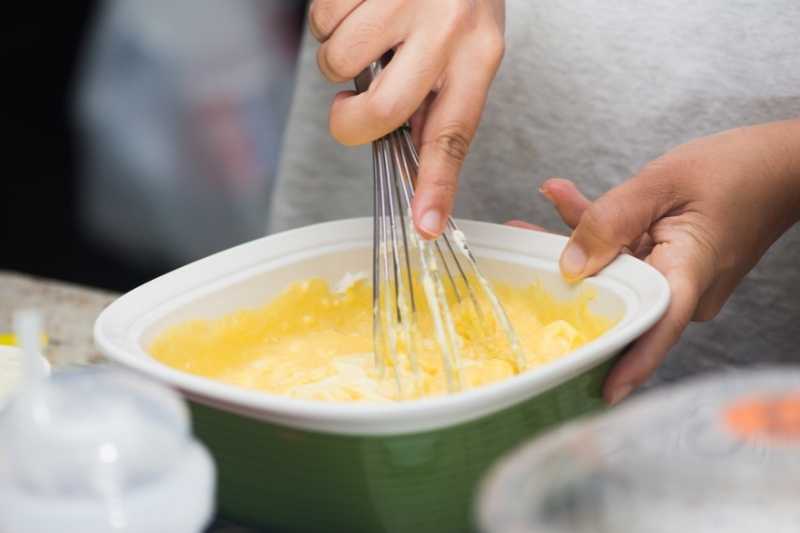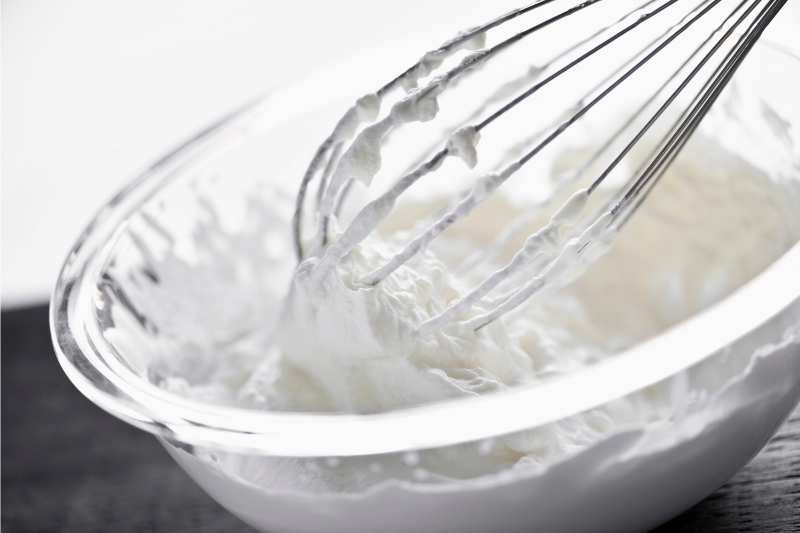This post contains affiliate links.
When it comes to baking, you might be wondering how to tell the difference between whisking and whipping. They sound like they do the same thing, but in reality, they have big differences when mixing ingredients. Knowing the differences between each mixing method as well as when to apply them will help your baked goods come out better than ever before.
Whisking is when you mix or blend ingredients together quickly using a whisk. It is mostly used for mixing wet ingredients like eggs while introducing air into the mixture. Whipping is when you vigorously mix light ingredients to make them frothy. It is mostly used for mixing cream or butter.
Throughout my research of this topic, I found out that there are still many questions that could arise about the whisking and whipping mixing methods. In this article, I will be discussing the real differences between whisking and whipping, as well as when to apply each technique individually.
What’s The Difference between Whisking and Whipping?
Whisking is intended to incorporate air into wet ingredients while mixing, and whipping is intended to vigorously mix wet ingredients to make them frothy. Whisking requires a thin wire whisk or whisk attachment while whipping uses a wooden spoon or paddle attachment as well as a whisk attachment.
Whisking is done quickly to mix ingredients together. Whipping, on the other hand, is more intentional and makes ingredients frothy and increase in volume.
Whisking also does not necessarily result in an aerated mixture like whipping. Instead, it’s used for mixing things that are lighter (like whipped cream). This means that whisked ingredients are typically not as frothy or thick.
While I like to do my mixing by hand, I much rather prefer using a Stand Mixer instead. I recently wrote an article that talks about the 3 Best Stand Mixers that bakers can buy in each stage of their baking journey. After reviewing a few stand mixers, the Best Overall Mixer was the KitchenAid Artisan Tilt-Head Stand Mixer. You can check out this stand mixer on Amazon!
While you can whip with a whisk, you can also use a paddle attachment or a wooden spoon.
Whipping, on the other hand, requires more time and energy, so it often results in a fluffier, frothy, and airier mixture. It is also used for ingredients that are heavier and need more volume (like cream or butter).
What is Whisking in Baking?
In baking, whisking is defined as quickly and vigorously mixing together wet ingredients to aerate them. It is often done with a whisk or, if you are using a mixer, a whisk attachment. The design of a whisk allows for the wet ingredients to gain volume through aeration.
So basically, whisking is a fast way to mix ingredients together. It is not as intentional as whipping and is used for wet ingredients.
How to Whisk When Baking
To whisk properly, you want to quickly move the whisk around the bowl in a circular pattern. This will help to combine all of the ingredients together while adding air at the same time.
It also helps when you lean the bowl slightly on its side to decrease the surface area which lets you whisk more of the ingredients.

*By the way, I recently wrote an article about All The Different Mixing Methods in Baking. This article talks about the 10 different mixing ways you can use when making your baked goods. You can check out this article here!
What is Whipping in Baking?
As a general rule, whipping involves beating an ingredient to add air to it. This can be done with a whisk, a mixer, or a wooden spoon, but a stand mixer with a whip attachment is ideal. It usually takes longer than whisking to achieve the desired results.
So whipping is more intentional than whisking and results in a more aerated mixture. It involves mixing to add more air to the ingredients.
Often, whipping is used for heavier ingredients like cream or butter making the whipping process take more time to do. Whipping requires vigorous flipping of heavy ingredients to incorporate air within each stroke.
How to Whip When Baking
When it comes to whipping, this is done with mixing bowls and whisks or mixers. You can also use an electric hand mixer or stand mixer for small amounts of ingredients like eggs, cream, or butter.
It is important to note that when you are whipping, it needs to be done slowly in order for the air bubbles to stay in place and produce volume.
*By the way, I recently wrote an article about The Differences Between Whipping and Beating. This article talks about how and when to use the whipping and beating mixing methods. You can check out this article here!
How Long Should You Whip Egg Whites?
When baking, it is recommended that you whip egg whites until they reach stiff peaks. This means that when you lift the beater out of the mixture, the peaks that form hold their shape and don’t droop. However, some recipes may call for soft peaks which have a more creamy texture.
How long to whip egg whites:
| Type of Peak | Whipping Time | Egg White Texture | When to Use |
| No Peak | Less than 2 minutes | Liquid, slightly foamy | For broths or consommes |
| Soft Peak | Up to 5 minutes | Thick, White, Creamy | Angel Food Cake, Waffles |
| Firm Peak | Up to 7 minutes | Peaks hold, tip folds in | Soft Meringues |
| Stiff Peak | Up to 10 minutes | Peaks hold, tip stands | Hard Meringues, Souffles, Ice Cream |
It usually takes about 5-7 minutes to achieve stiff peaks with a hand mixer or stand mixer at high speed. If you are using a whisk, it will take longer since you won’t be able to incorporate as much air into the mixture.
How to Whisk Egg Yolks?
Whisking egg whites is different from whisking a mixture of egg yolks and sugar. When it comes to the latter, there are no stiff peaks or creating volume with air bubbles. You want to beat the eggs until they become pale yellow in color and have thickened slightly.
This means that when you lift the whisk out of the mixture, it should fall back into the bowl in ribbons rather than droplets. This usually takes about five minutes with a hand mixer or stand mixer on low to medium speed.
While mixing by hand is great, having some kind of electric mixer has saved me so much time throughout my whisking and whipping process.
*Side Note: I recently wrote an article about The Differences Between Whisking and Beating. This article talks about when you are supposed to use each of these mixing methods. You can check out this article here!
How Long Should You Whisk Eggs?
When baking, you want to whisk your eggs for about a minute. Start off slow until the eggs are foamy and then increase your speed. This will help them to blend together and incorporate the air which creates a frothy and thicker mixture.
To help the whites stabilize properly, you might want to add a pinch of cream of tartar. It will also help if you are concerned about the eggs not stiffening properly when whisked for long periods of time.
*Side Note: I recently wrote an article that talks about Why Your Buttercream Frosting is So Grainy. This article talks about how to fix grainy frosting by making it smooth again. You can check out this article here!
Can You Use A Whisk To Whip Cream?
As a general rule, you can use a flat whisk or balloon whisk to whip cream. Whipping cream by hand is a tedious process but can be done with a few tricks. Make sure your bowl and whisk are chilled in the freezer for 5 minutes. This allows the cream to thicken faster.
While you could technically whisk cream by hand, it is not the best idea for creating the best whipping. Whisking cream by hand will take longer to whip the cream than a mixer and you might not achieve the same level of results.

To accelerate the process, a trick I always use for both a hand whisk and a whisk attachment is to chill prior to whipping. I take my bowl and a whisk and place them into the freezer for about 5 minutes.
This allows the cream to thicken faster (and prevent it from melting quickly) when whipping.
*By the way, I recently wrote an article that talks about Why Your Buttercream Frosting is So Runny. This article talks about how to fix runny frosting by making it thicker. You can check out this article here!
Can You Whisk and Whip without a Mixer?
As a general rule, you can whisk and whip ingredients without a mixer. However, it will take significantly longer and might not be as successful. A stand mixer or handheld mixer is ideal for these tasks because they incorporate more air into the mixture quicker.
A whisk can also be used to mix together wet and dry ingredients for a cake or bread batter. It’s important to use it in the correct way so that you don’t overmix your batter.
*By the way, you might also want to know How To Mix Batter Without a Mixer. I recently wrote an article talking about The Right Ways of Mixing Batter By Hand, which you can check out here!
When Should You Whisk?
As a whole, whisking is done when wet ingredients are used and need to be combined with a smooth texture. Incorporating air into the wet ingredients gives it a silky, smooth appearance. The key in baking is to thoroughly combine your wet ingredients before adding the dry ingredients.
You want to whisk until the ingredients are fully combined. This will take about a minute for most mixtures. It is complete when you see all wet ingredients have been incorporated and have a nice smooth yet foamy texture.
When Should You Whip?
On average, whipping is done when the ingredients need more volume and a thick texture. Using cream as an example, whipping cream allows the liquid to aerate which thickens the ingredients. The volume of the cream exponentially increases and transforms into a more solid state.
Whipping can take anywhere from 2-10 minutes depending on the liquid you are using. With the previous example, whipped cream usually takes about 5 minutes for a softer texture or 10 minutes for a stiff peak cream.
*Side Note: I recently wrote an article about The 5 Main Methods of Baking. This article talks about how and when to use each baking method when making your baked goods. You can check out this article here!
To Summarize…
It is important to understand the difference between whipping and whisking. It is also important to know when each technique should be used, as well as how it affects the end product.
Learning when to use the proper method when baking has helped my desserts come out better than ever before! I hope this article has been helpful to you in your baking journey!

